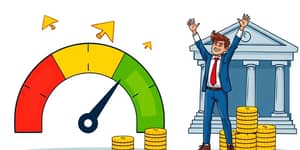Payday and other high-cost, short-term loans present a paradox: they promise quick relief but often deepen financial distress. Understanding these risks and exploring alternatives can help individuals break free from destructive borrowing cycles.
Understanding Payday and Short-Term Loans
Payday loans are small-dollar, short-term advances typically due on the borrower’s next paycheck. Car-title loans, installment loans, and pawn loans share similar features: minimal qualification requirements, rapid approval, and sky-high interest rates.
While marketed as solutions for emergencies, these products primarily target financially vulnerable and underserved consumers. In the United States, around 12 million people borrow payday loans each year, paying roughly $7.4 billion in fees. Nearly 17,000 storefronts nationwide supply these high-cost funds to individuals with poor or nonexistent credit histories.
The Debt Trap: Why It Spreads
At first glance, a two-week loan for $200 may seem manageable. However, with annual percentage rates (APRs) ranging from 196% to 359%, the true cost mounts quickly. Missing a repayment leads to rollovers, new fees, and mounting balances.
- Over 80% of payday loans are rolled over into new loans before payoff.
- Seventy-five percent of borrowers take out another loan within two weeks.
- Many borrowers renew loans as many as ten times before clearing the balance.
This cycle of repeat borrowing traps individuals in persistent financial hardship. Each renewal adds fees, interest, and stress, making it nearly impossible to escape without external help.
The Human Toll Beyond the Numbers
Behind the statistics lie personal stories of anxiety, shame, and exhaustion. Consider Maria, a single parent facing a sudden medical bill. With no other options, she takes a $300 payday loan. Two weeks later, she still owes $375 after fees. Unable to repay in full, she renews and quickly owes more than $500.
Maria’s story is far from unique. Many borrowers report sleepless nights, strained relationships, and worsening health as they juggle multiple high-cost obligations. Aggressive collection practices exacerbate distress, leading to mental health challenges like depression and anxiety.
Financial stress also spills over into physical wellbeing. Studies link the burden of high-interest debt to elevated blood pressure, weakened immune response, and unhealthy coping mechanisms, deepening existing inequities among marginalized communities.
Regulation and Its Unintended Consequences
In response to widespread criticism, fourteen states and the District of Columbia have banned payday loan storefronts. Others have capped APRs or restricted rollovers. While these measures protect some borrowers, they can have unintended effects.
Tighter rules have led to a 42% drop in approved payday loans since 2013, leaving an estimated 600,000 consumers without any emergency credit access. As a result, some turn to unregulated loan sharks, expensive bank overdrafts, or high-fee check-cashing services—solutions that may be even costlier in the long run.
The Consumer Financial Protection Bureau continues to weigh stricter regulations alongside concerns about driving vulnerable individuals toward riskier alternatives. Striking a balance between consumer protection and credit access remains a contentious policy challenge.
Data and Statistics Summary
Finding a Way Forward: Safer Alternatives and Practical Steps
Escaping the payday loan cycle requires planning, education, and access to better options. Below are actionable strategies to reduce reliance on high-cost borrowing and build financial resilience.
- Build an Emergency Fund: Start small by saving a few dollars each week in a dedicated account. Even $500 can cover many unexpected expenses.
- Explore Credit Union Loans: Many credit unions offer small-dollar loans with APRs below 18% and flexible repayment plans.
- Negotiate with Service Providers: Contact utilities or medical offices to arrange payment plans or hardship programs that avoid high fees.
- Seek Professional Counseling: Nonprofit credit counseling agencies can help create a realistic budget and debt repayment plan.
- Consider Community Resources: Churches, charities, and local agencies may offer grants, emergency funds, or interest-free loans for those in crisis.
In addition to these steps, improving financial literacy is crucial. Free online courses and workshops can empower individuals to manage credit wisely, understand interest rates, and plan for future expenses.
Conclusion: Breaking Free and Building Financial Resilience
Payday and short-term loans promise quick relief but often deepen financial distress through high fees and repeat borrowing. While regulation aims to curb predatory practices, no single policy can fully shield individuals from unexpected emergencies or lack of credit access.
Combining consumer protections with education, community support, and safer credit options is key to breaking the payday loan cycle. By taking proactive steps—saving regularly, seeking lower-cost loans, and utilizing professional advice—borrowers can regain control, reduce stress, and build a stronger financial future.
Ultimately, the journey beyond payday loans involves more than escaping debt; it’s about fostering a sense of dignity, stability, and hope. With the right tools and support, anyone can transform a moment of crisis into an opportunity for lasting change.
References
- https://debthammer.org/payday-loan-debt-statistics/
- https://www.responsiblelending.org/issues/payday-and-other-small-dollar-loans
- https://www.bankrate.com/loans/personal-loans/payday-loan-statistics/
- https://riskonnect.com/compliance/industry-news-has-regulation-gone-to-far-in-the-payday-loan-industry/
- https://humanimpact.org/hipprojects/paydaylendinghia/
- https://www.canopyservicing.com/blog/small-business-lending-statistics/
- https://www.pew.org/en/research-and-analysis/articles/2023/06/07/what-does-the-research-say-about-payday-loans










